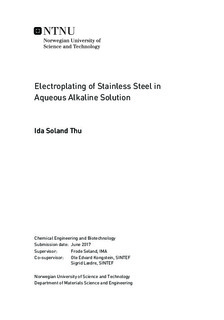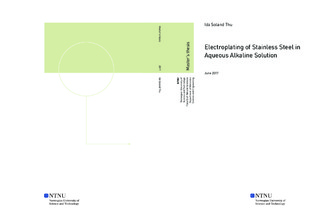| dc.description.abstract | Electroplated stainless steel alloys containing elements such as iron, chromium and nickel, are of great interest in production of electronics and nanotechnology devices. Previous methods for electroplating of these alloys have been found problematic because of little control of composition and layer thickness of the electroplated layers. A new method for electroplating of Fe-Ni-Cr alloys is therefore desirable. The proposed method studied in this work is electrochemical reduction of metal oxides onto a conductive substrate. The ultimate goal is to develop a reproducible method for electroplating Fe-Ni-Cr alloys onto any conductive substrate, however, the focus in this work was to successfully reduce a mixture of oxides of iron and chromium to an alloy containing the respective metals. Mixtures of Fe2O3-Cr2O3 or Fe2O3-Cr(OH)3 were coated onto Cu substrates and reduced in 50 wt% aqueous NaOH at 114 degrees celsius under a constant cathodic current. Current and reduction time were varied and their effect on the deposits were studied using optical microscopy (OM), scanning electron microscopy (SEM), energy dispersive spectroscopy (EDS), x-ray diffraction (XRD) and x-ray photoelectron spectroscopy (XPS). Purification of the electrolyte using both a chemical and an electrochemical method, were also pursued. Inductively coupled plasma mass spectrometry (ICP-MS) was used to analyze the electrolyte before, during and after purification, with respect to the content of iron and nickel. In addition, measures to enhance the adhesion of the oxide layers were taken.
SEM images revealed crystals growing on the surface of most samples, which possibly grew, predominantly, through a dissolution-redeposition mechanism. Further analysis with EDS revealed a high content of iron compared to that of oxygen, some chromium was also detected in all samples. However, additional analysis with XRD was necessary to confirm reduction of the oxides. No oxides were detected with XRD, which indicated a successful reduction of the analyzed samples. Further analysis with XPS confirmed the presence of both metallic and oxidized iron, which is to be expected when a metallic surface is analyzed. Small amounts of oxidized chromium was detected and no metallic chromium was found. However, this method only analyzes the topmost 5-10 nm. Consequently, it is possible that the chemistry of the layer is different further down in the sample, as indicated by the XRD analysis where no oxides were detected. It was found that a large cathodic current (-15 A) and long reduction times (5 h) were the most successful, as this resulted in thicker and more uniform layers with a higher content of chromium.
ICP-MS results revealed that the chemical method used for purification, employing high purity Ni(OH)2 for absorption of iron, was significantly successful in the removal of iron down to almost 1 %. However, the method increased the nickel content in the electrolyte, which is unwanted as nickel is likely to co-deposit along with reduction of the metal oxides. The electrochemical method, which consisted of pre-deposition of metal ions from the solution, was slightly less successful in the removal of iron, but did also reduce the nickel content. Additionally, this method enabled larger volumes to be purified in an acceptable short time, and has the potential of reducing the amounts of all metal impurities. Therefore, the electrochemical method for purification was preferred.
The new electroplating method for reduction of metal oxides to their respective metals showed promising results. However, additional characterization of the deposits is necessary to accurately determine whether full reduction of the oxide mixtures was achieved. In addition, further study is necessary to elucidate the operating conditions for successful reduction of Cr2O3 and Cr(OH)3, and subsequently also the reduction of a nickel oxide, into their respective metals. Furthermore, better adhesion of the oxide layers is necessary to come closer to the ultimate goal of developing a reproducible method for electroplating of Fe-Ni-Cr alloys onto any conductive surface, with precise composition and thickness control. | |

